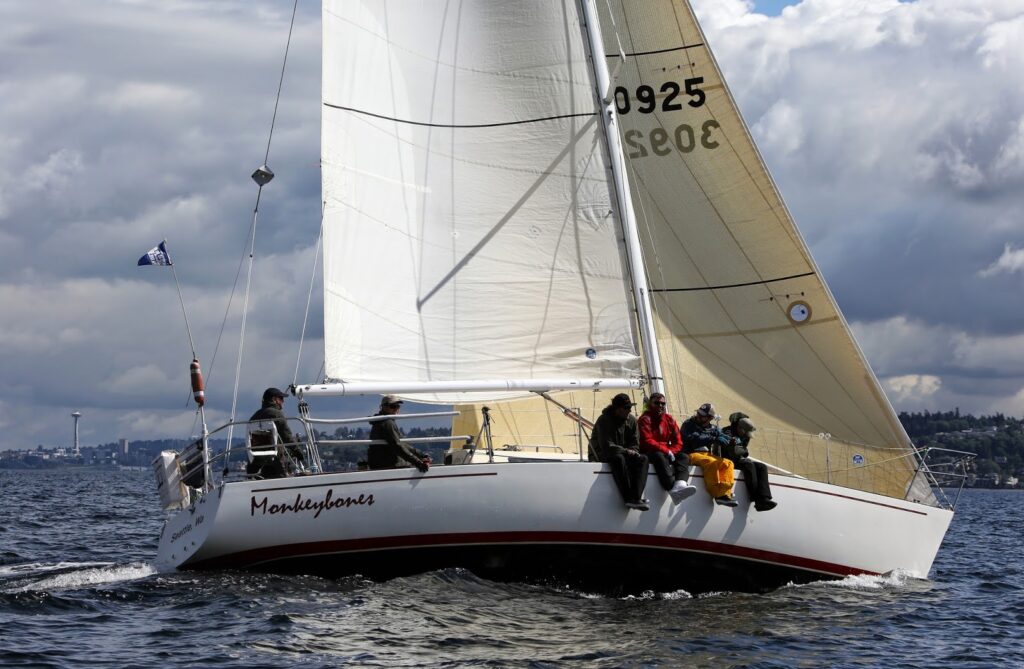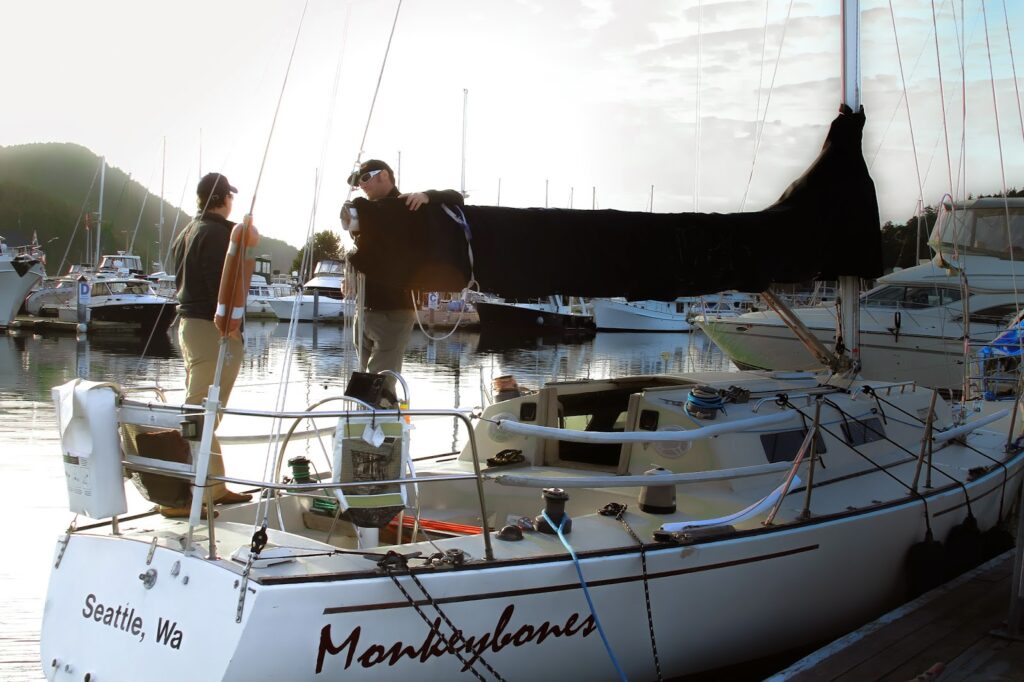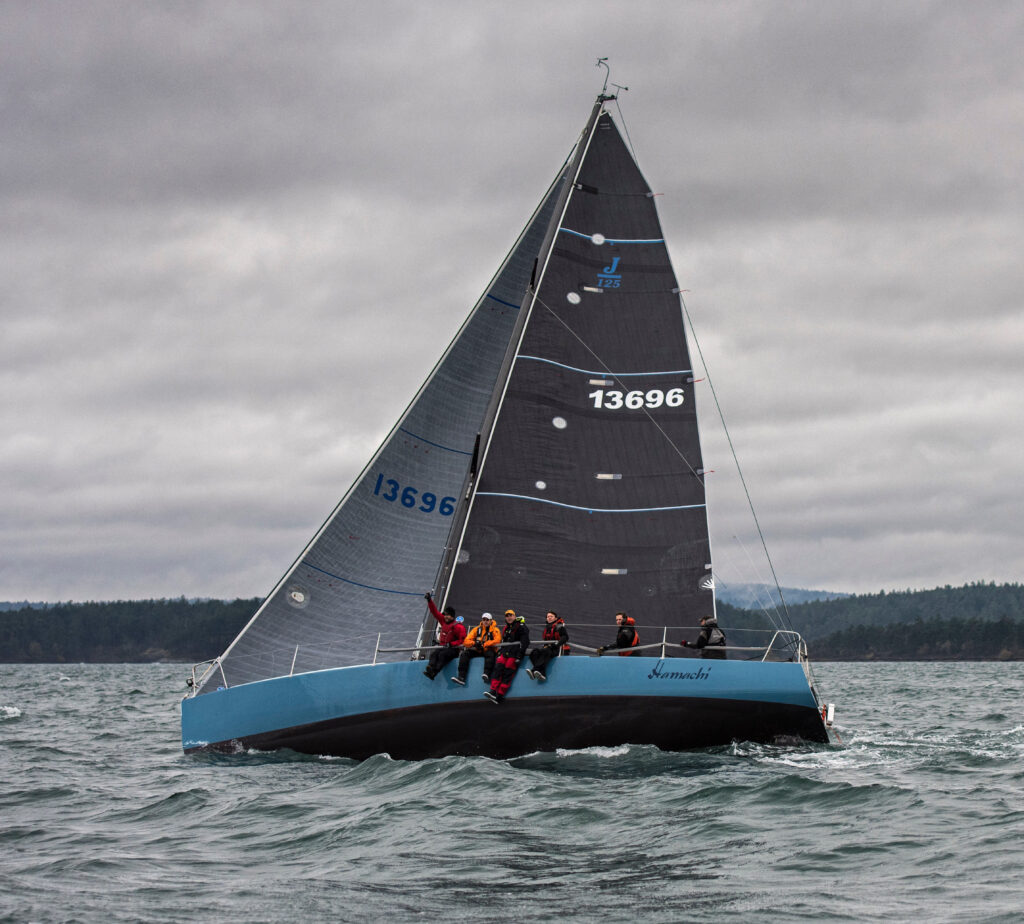We are all about adventures. In the world of sailboat racing, participating in a Transpac (Trans Pacific) yacht race from Long Beach, CA to Oahu, Hawaii is one of the ultimate adventures. The bi-annual race covers 2260 miles of distance and attracts the biggest boats and most accomplished sailors from around the world. In March we entered our J/125 Hamachi into the 2019 Transpac, which is the 50th edition of this classic race.
Our Transpac campaign is the latest destination on a long sailing voyage that began in 2012. In 2011, during a rough patch in our family business, we seriously considered selling it all and sailing to far off destinations with the family. I grew up around water in Seattle and learned to sail on a dinghy skiff during summers in the San Juan Islands. In highschool and college I commercial fished on a small boat in Alaska and after college spent three months crewing on a 120 ft schooner in Long Island Sound. However, neither I nor the family had spent any time on a larger keelboat. During fishing outings in the San Juan Islands my good friend Shawn and I discussed my desire to buy a sailboat and head out. These conversations lead to each of us becoming one third share owners in a local J/36, which seemed like a good way to explore sailing with the family. This J/36, named Monkeybones, was owned by Shawn’s neighbor and had been in the PNW for 5-6 years. The owner occasionally raced at the Elliott Bay Downtown Sailing Series and was trying to sell the boat. We came in as part owners and breathed new life into the boat, and the program.
The boat itself was pretty tired. It was shipped up from Houston and had clearly suffered at the hands of a hurricane (or two). The J/36 has a “woody” interior and the cabin had water damage clearly indicating it had been flooded at one point. The engine was recently replaced, but the boat had no working instruments, needed new electrical, and had a meager sail inventory. Our very first local race was the 2012 Race to the Straits, which is a double handed race. I had never been in a sailboat race before, nor ever set a spinnaker. Luckily Shawn spent several of his formative years racing sailboats and even did a delivery back from Hawaii to Seattle. As a result, he drove and I did everything else. The boat had no working instruments so we relied on the wind index for trimming. In hindsight we probably shouldn’t have started with a double handed race, but that also defines our attitude towards life” “go big or go home”. We finished bottom third and discovered we both loved the adventure of sailboat racing.

The J/36 was one of the first large keelboats made by brothers Rod and Bob Johnstone. Around 55 J/36’s were produced during 1981-1984 and they quickly discovered that the boat was too expensive to produce. As a result they kept the same hull mold and modified the rig (fractional to masthead) and steering (wheel to tiller) and renamed it the J/35, which went on to be one of the best selling racer / cruiser sailboats of its era. For Shawn and I, the J/36 was a great learning platform. It had a PHRF rating of 81, which meant we had the same rating as Dos, Different Drummer, and (the original) Absolutely. We chased those boats around the course for years, frustrated that we couldn’t catch them. Only now do we appreciated that those are the best boats in the fleet. I’m sure our early sailing forays were comical to the rest of the fleet, but it was the best way to get a crash course on all aspects of sailboats and racing and sailing head to head with those top boats made us better sailors. Each year we expanded the number of races as well as participated in bigger and bigger events.

By 2015 Monkeybones was a regular on the race course and even competitive. Shawn and I had built a crew and settled into our usual roles – he drove and I ran the boat. The highlights of every season were the double handed races: the STYC’s Race to the Straits and the AYC’s Northern Century. As the deck guy these were exhilarating but exhausting events and I began to talk about buying a new boat that would be easier to double hand. I was tired of the heavy spinnaker pole and sometimes dicey double handed spinnaker jibes. “Let’s get a sprit boat,” I would say, “and while we are at it let’s get one that planes.”
By 2016 we were starting to look around and do serious window shopping. We had also concluded that Shawn and I love racing, and the family does indeed enjoy cruising, but they prefer catamarans in warm tropical waters. As a result our focus was to find a true racing boat that met our simple design requirements and also allowed us to do bigger sailing adventures. Everyone in the PNW knows Paul Bieker’s Riptide 35 Terremoto and I started investigating what it would take to buy a Bieker boat. We made a run at Terremoto’s sister ship Ripple, which is languishing in Long Beach, but got the same response from the owner as everyone else: “not selling”. We started looking at other J/boats and got interested in the J/125.
Most J/boats are dual purpose racer / cruisers. In the late 1990’s J/boats developed the J/125 as a true racer. It was built entirely of carbon composite with a long narrow “canoe hull” designed to punch through offshore waves. It had a long carbon sprit and a short powerful rig. The boat was many year ahead of its time technologically and an excellent performer. However, it was too expensive for the racer/cruiser J/boat community and true racers looked down their noses at J/boats (it was like buying a sports car from Volkswagen). As a result it was a commercial disaster and only 16 were produced. Since the end of production their value and reputation has steadily increased and they rarely came on the market. In the summer of 2016 we watched Double Trouble, which was a very accomplished Bay Area J/125, go on the market and get sold. Several months later Greg Slyngstad put the local J/125 Hamachi on the market.
In many ways, we had no business jumping into a program like Hamachi. Greg is a very accomplished businessman who built Hamachi into a world class racing program. He won his class in the 2014 PacCup and 2015 Transpac with a crew of professionals that included local legends Jonathan McKee, Fritz Lanzinger and others. He invested heavily in Hamachi to make it the best boat in its fleet complete with the infrastructure to campaign it all around the Northern Hemisphere. In 2016 he was just launching Fujin, the now famous Bieker 53 ft catamaran, and was turning his sailing focus to that program.
We completed the purchase of Hamachi three days before the 2016 Round the County Race. We had no experience with the boat, but sailed the boat north anyway and a day later found ourselves on the start line off Lydia shoal in 30-35 kts of wind. We were no longer in the middle PHRF fleet, but instead in the top ORC fleet screaming alongside the TP52s. It was like going from a family sedan to a Ferrari. Shawn and I looked at each other with nervous grins – “go big or go home!” Luckily one J/boat isn’t too different from another and we survived that race and didn’t break anything.

Over the next two years we learned the boat and how to sail it, and continued to expand our program and crew. In 2017 we committed to all of the local races and set out on our next adventure: the VanIsle 360, which is a two week 600 mile race around Vancouver Island. We were on a very steep learning curve. The J/125 was built as an offshore race boat and optimized for fast downwind sailing. Unfortunately that is a rare occurrence around Puget Sound so we have spent the vast majority of our time honing our upwind and light air skills. We finally got opportunities to “send it” down the race course on Legs 5 and 8 of the VanIsle 360. Leg 5 was a white knuckled downwind blast in a gale from Telegraph Cove to Port Hudson. Hamachi nearly beat the committee boat to the finish line and set a new course record of 2.5 hours, breaking Icon’s old record by almost two hours. We then got the offshore sleigh ride the boat was designed for from Ucluelet to Victoria. It was after that race that Shawn and I started seriously discussing a race to Hawaii.
Knowing that we needed more experience we discussed entering the Newport to Puerto Vallarta race in 2018. Life events conspired to make that impossible. Instead we have a friend who runs a successful J/109 program in Chicago and wound up crewing on Callisto for the 115th race from Chicago to Mackinac Island (Chicago Mac). The race is 330 miles across the length of Lake Michigan and is the largest “offshore” race in America, with over 300 boats participating. The lake has a reputation for nasty weather and the 115th edition delivered. A weather front made it a three day upwind slog in heavy weather with sketchy conditions at the start that unfortunately claimed one sailor’s life. It was great training on boat safety, navigation and establishing a high misery index.
As 2018 drew to a close we began to get serious about Transpac. Timing wasn’t great for either of us, but it was the 50th edition with the largest fleet in race history and what appeared to be the largest gathering of J/125’s in any race to date. We finally committed by submitting our application in the last hour to avoid the higher late entry penalties. And thus began a very rushed campaign to assemble our boat and crew.